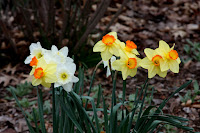Fall Planted Bulbs for Spring Flowers
 The time to plant spring blooming bulbs has arrived along with an abundance of bulb company catalogs.
The time to plant spring blooming bulbs has arrived along with an abundance of bulb company catalogs. Becky Heath of Brent and Becky's Bulbs has an article in this month's American Horticultural Society newsletter. You can read the entire article at this link.
Heath says, "There are several approaches to combining bulbs with herbaceous perennials, shrubs, and trees. Choosing combinations that will bloom at the same time creates the biggest impact, like the finale of a fire - works display. Combining plants so that they bloom sequentially with a slight over -plant tulips or lilies eight to 10 inches deep, then above them place daffodils, hyacinths, or alliums at about six inches. Smaller early-blooming bulbs—such as crocuses, anemones, and dwarf irises—can even be planted in the top three inches."
Heath's bulb-planting tips
The best time to plant spring-flowering bulbs is after the first hard frost. Before then, the soil normally remains warm from the summer heat, and early autumn rains may cause newly planted, non-established bulbs to rot.
The basic rule of thumb for planting depth is three times the height of the bulb. So if the bulb is two inches tall, then the bottom of the hole should be about six inches deep. Tulips and lilies, which prefer really cool soil, benefit from being planted even deeper—I often suggest placing them eight to 10 inches deep.
The roots of spring-flowering bulbs start growing in autumn, so after planting, water the area and add a topdressing of compost or a slow-release fertilizer that is low in nitrogen and high in potash (5–10–20).




Comments